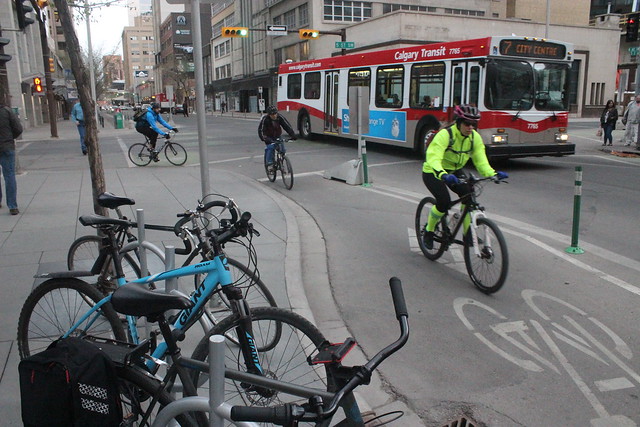Remember the war on cars? The hyperbolic and mostly mythical idea that cyclists, a “special interest group,” were successfully ramming such horrors as bike lanes down the throats of unsupportive legions of car drivers? Since the peak “war on cars” battles of four or five years ago, the hot war has cooled a bit because cyclists made a little progress and the sky did not fall as a result. Most cities now have at last some form of bike infrastructure and some have even have what might be described as a (barely) minimum grid of bike lanes.
These days, further demands of cyclists are greeting less with anger, and more with exasperation. “We gave you a bike lane, but you still want more?” That attitude has wrought sentiments like this one, a general sense that since we threw those “cyclists” a bone, they should be satisfied. Much of this attitude comes about because of a sense that the bikes won the war.
Here’s the thing: if the war on cars is over, it didn’t end the way you might think. If you look at it even a little objectively, it’s not the bikes that won. Cars are absolutely dominating the battle. It’s not even close. It’s Norman Schwarzkopf versus Iraq. It’s Germany versus Brazil in the 2014 Word Cup.
Consider these statistics. The U.S. Department of Transportation’s 2017 measure of vehicle distance travelled set a record after a slight dip over the last several years. Americans drove automobiles more miles in 2017 than any other time in history. Furthermore, according to the American Community Survey, the number of car-free households dropped to its lowest rate in nearly a decade, and there are now more two-car households than any other kind. Here’s how urban planner and historian Sarah Jo Peterson put it: “The United States lost 200,000 car-free households and 350,000 families with only one car in 2016. These losses are on top of losses of 100,000 car-free households and 125,000 car-one families in 2015.”

Remember the idea that millennials were shunning cars? Sure, there may be a bit of that happening, but the latest automobile sales statistics in Canada show that, with the economic recovery in full swing, 186,837 automobiles were sold in September, a record increase of 7.7 per cent, and the eighth monthly record this year. “Cumulative sales of 1,591,684 vehicles through the first three quarters are 5.3% ahead of last year’s record pace and solidly on track for a fifth consecutive record sales year.”
Wait, it gets worse: The U.S. Department of Transportation found the fatality rate on American roads actually grew in 2016, despite decades of trend lines pointed downwards. Advances in safety seem to be reserved only for those inside the car. Cyclist deaths in 2016 increased by 1.3 per cent and the pedestrian fatality rate grew by a whopping nine per cent, meaning more humans simply walking on the street were killed in 2016 than any time since 1990.
Meanwhile, the bike world inches along at a snail’s pace. Los Angeles is just getting started building bike lanes, New York is inexplicably cracking down on e-bikes, and Toronto continues its tiresome debate about whether successful and safe separated bike lanes ought to stay or go.
The point of this isn’t to depress those of you who see bikes as one way of bringing more balance and sanity to our streets. The point is to highlight the absurdity of the “war on cars” argument. Even if there was a war, it’s ridiculous to think that a few bike lanes scattered through our urban centres has made a dent in the dominance of automobiles in North America. We know the reasons most people make the transportation choices they do: convenience. Outside of a few isolated neighbourhoods in a few isolated cities, we’ve built our communities to ensure that driving a car remains the fastest, most convenient way to get around. Until that changes, vehicles will continue to dominate.
The most we can hope for is that these (barely) minimum grids that have been built in some cities will open the eyes of enough people to see the benefits of active transportation so we can leave behind the stupid war metaphors and start building better cities for everyone together.
These new statistics are a sobering reminder of our auto-centric ways, but that doesn’t mean we should give up. Building better cities takes time, and we’ve barely taken the first steps. Get back on that bike.
Follow Shifter on Facebook or Medium.
Follow Tom Babin on Twitter, Facebook or Medium.
Tom Babin is the author of Frostbike: The Joy, Pain and Numbness of Winter Cycling.
The war on bikes has escalated: http://www.telegraph.co.uk/news/2017/11/01/new-york-attack-eight-dead-truck-hits-cyclists/ !
This comment on the Glib and Stale piece about Vancouver is hilarious:
“We will never be Amsterdam……….we are not flat, we are not dense ( 50 x 159 ft lots) and it rains 200 days a year if not snowing”.
Obviously the commenter has never been to Amsterdam, which is at least as rainy as Vancouver (often cold, nasty rain). And while they are flat, facing the winds from the North Sea is like climbing a never-endinng hill.
As for the terrorist war on bikes, the reactionary nature of such terrorism is evident from their fondness for attacking public transport (London, Madrid etc) and crowds of people on foot (Nice, Boston Marathon) and cycles (NYC). I’ve only cited Western targets but I’m sure this is even more the case in the Middle East and South Asia. They are fond of targeting places like public markets, full of innocent pedestrians. And they destroyed the famous markets of Alep, one of the oldest examples of pedestrian-oriented commercial and social spaces on Earth.
Always look forward to what Mr. Babin has to say about cycling!
An amusing read, not unrelated:
https://beta.theglobeandmail.com/news/british-columbia/vancouver-cyclists-are-reaching-peak-entitlement/article36680763/?ref=https://www.theglobeandmail.com&
Thanks Gunther!